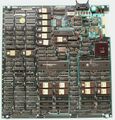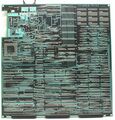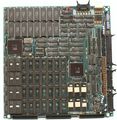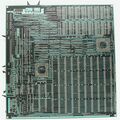Difference between revisions of "Sega OutRun hardware"
From Sega Retro
m (Text replacement - "maker=Sega" to "maker=Sega Enterprises, Ltd.") |
|||
| (56 intermediate revisions by 6 users not shown) | |||
| Line 4: | Line 4: | ||
| imgwidth=320 | | imgwidth=320 | ||
| name= | | name= | ||
| − | | maker=[[Sega]] | + | | maker=[[Sega Enterprises, Ltd.]] |
| − | | releases={{ | + | | releases={{releasesArcade |
| − | | | + | | system_date_world=1986-09-20 |
| − | | | + | | system_code_world=171-5376{{ref|[https://github.com/mamedev/mame/blob/master/src/mame/drivers/segaorun.cpp Sega OutRun hardware (MAME)]}} |
}} | }} | ||
}} | }} | ||
'''Sega's OutRun hardware''' was released in 1986 with the driving game ''[[OutRun]]''. It is a successor to their [[Sega Hang-On Hardware|Hang-On hardware]], making it the second in [[Sega]]'s [[Super Scaler]] series of three-dimensional arcade hardware. It was succeeded by the [[Sega X Board]] in 1987. | '''Sega's OutRun hardware''' was released in 1986 with the driving game ''[[OutRun]]''. It is a successor to their [[Sega Hang-On Hardware|Hang-On hardware]], making it the second in [[Sega]]'s [[Super Scaler]] series of three-dimensional arcade hardware. It was succeeded by the [[Sega X Board]] in 1987. | ||
| − | The OutRun hardware, like the Hang-On hardware, has specifications similar to those of the [[System 16]], with the addition of a second [[68000]] processor and a separate video board which allowed for an extra graphics layer for the road as well as [[sprite]]/texture scaling capabilities. The OutRun hardware can do everything the Hang-On hardware can do, but its processors are clocked higher (allowing for quicker calculations), it has more memory, and the video board's capabilities have been expanded, capable of drawing two roads (the Hang-On hardware can only draw one) and rendering sprites/textures using a framebuffer system with a higher fillrate (the Hang-On hardware used a line-buffer system). | + | The OutRun hardware, like the Hang-On hardware, has specifications similar to those of the [[System 16]], with the addition of a second [[68000]] processor and a separate video board which allowed for an extra graphics layer for the road as well as [[sprite]]/texture scaling capabilities. The OutRun hardware can do everything the Hang-On hardware can do, but its processors are clocked higher (allowing for quicker calculations), it has more memory and faster bandwidth, and the video board's capabilities have been expanded, capable of drawing two roads (the Hang-On hardware can only draw one) and rendering sprites/textures using a framebuffer system with a higher fillrate (the Hang-On hardware used a line-buffer system). At the time, the OutRun hardware was a very powerful but expensive arcade board, with arcade operators advised to charge twice as many credits than for regular arcade machines. |
Three games made use of the hardware, all of which are driving games. However, only ''[[OutRun]]'' and ''[[Turbo OutRun]]'' are truly for this hardware, as ''[[Super Hang-On]]'' was also released for the Hang-On hardware in a mostly identical form. | Three games made use of the hardware, all of which are driving games. However, only ''[[OutRun]]'' and ''[[Turbo OutRun]]'' are truly for this hardware, as ''[[Super Hang-On]]'' was also released for the Hang-On hardware in a mostly identical form. | ||
| − | ==Technical | + | ==Technical specifications== |
| − | * Board composition: CPU Board (Main Board), Video Board {{ref|[https://github.com/mamedev/mame/blob/master/src/mame/drivers/segaorun.cpp Sega OutRun | + | ===Sega OutRun specifications=== |
| − | * Main [[wikipedia:Central processing unit|CPU]]: 2× [[68000]] @ 12.5 MHz: 16/32‑bit instructions, 4.375 MIPS, 32‑bit (2× 16‑bit) data bus, 44‑bit (24‑bit, 20‑bit) address bus {{ | + | * Board composition: CPU Board (Main Board), Video Board{{ref|[https://github.com/mamedev/mame/blob/master/src/mame/drivers/segaorun.cpp Sega OutRun hardware (MAME)]}} |
| − | * Memory Mapper [[wikipedia:Field-programmable gate array|FPGA]]: Sega 315‑5195 Memory Mapper @ 40 MHz: 16‑bit data bus, 24‑bit address bus {{ref| | + | * Main [[wikipedia:Central processing unit|CPU]]: 2× [[68000]] @ 12.5 MHz: 16/32‑bit instructions, 4.375 MIPS, 32‑bit (2× 16‑bit) data bus, 44‑bit (24‑bit, 20‑bit) address bus{{fileref|OutRun Schematics.pdf|page=2}} |
| + | * Memory Mapper [[wikipedia:Field-programmable gate array|FPGA]]: Sega 315‑5195 Memory Mapper @ 40 MHz: 16‑bit data bus, 24‑bit address bus{{ref|[https://github.com/mamedev/mame/blob/master/src/mame/video/segaic16.cpp Sega 16‑Bit common hardware (MAME)]}}{{fileref|OutRun Schematics.pdf|page=2}} | ||
| − | ===Sound=== | + | ====Sound==== |
{{multicol| | {{multicol| | ||
* Sound CPU: [[Zilog]] [[Zilog Z80|Z80]] @ 4 MHz (8/16‑bit instructions, 0.58 MIPS) | * Sound CPU: [[Zilog]] [[Zilog Z80|Z80]] @ 4 MHz (8/16‑bit instructions, 0.58 MIPS) | ||
| − | * Sound chips: 2 chips, 24 channels, 24‑bit bus width {{ | + | * Sound chips: 2 chips, 24 channels, 24‑bit bus width{{fileref|OutRun Schematics.pdf|page=8}} |
| − | + | :* [[wikipedia:Frequency modulation synthesis|FM synthesis]] chip: [[Yamaha YM2151]] @ 4 MHz (8 FM channels, 8‑bit bus width){{fileref|YM2151 datasheet.pdf}} | |
| − | + | :* [[Pulse-code modulation|PCM]] sampling chip: [[SegaPCM]] 315‑5218 Sound Controller @ 4/16 MHz{{ref|[https://github.com/mamedev/mame/blob/master/src/mame/drivers/segaorun.cpp Sega OutRun hardware (MAME)]}} ([[wikipedia:Stereophonic sound|stereo]] output, 16 PCM channels, [[wikipedia:Audio bit depth|12‑bit audio depth]],{{intref|Sega "X-Board" hardware notes (2004-12-03)}} 31.25 kHz [[wikipedia:Sampling rate|sampling rate]], 16‑bit bus width) | |
| − | * Sound [[wikipedia:Digital-to-analog converter|DAC]]: [[Yamaha]] YM3012 @ 4 MHz: 16‑bit floating‑point dynamic range {{ | + | * Sound [[wikipedia:Digital-to-analog converter|DAC]]: [[Yamaha]] YM3012 @ 4 MHz: 16‑bit floating‑point dynamic range{{fileref|YM3012 datasheet.pdf}} |
| − | * Sound FPGA: Sega 315‑5223A (Signetics CK2605) @ 16 MHz: 8‑bit bus width {{fileref|303A-011A Device List.pdf|page=11}}{{fileref|CK2605 Fusemap.pdf}} | + | * Sound FPGA: Sega 315‑5223A (Signetics CK2605) @ 16 MHz: 8‑bit bus width{{fileref|303A-011A Device List.pdf|page=11}}{{fileref|CK2605 Fusemap.pdf}} |
}} | }} | ||
| − | ===Graphics=== | + | ====Graphics==== |
{{multicol| | {{multicol| | ||
| − | * Video Board [[wikia:w:c:gaming:Graphics processing unit|GPU]]: Sega 171‑5377 VIDEO Board graphics chipset @ 25.1748 MHz: 6 processors, 80‑bit RAM ( | + | * Video Board [[wikia:w:c:gaming:Graphics processing unit|GPU]]: Sega 171‑5377 VIDEO Board graphics chipset @ 25.1748 MHz: 6 processors, 80‑bit RAM (167.521366 MB/s), 64‑bit ROM (37 MB/s){{ref|[https://github.com/mamedev/mame/blob/master/src/mame/drivers/segaorun.cpp Sega OutRun hardware (MAME)]}}{{ref|[https://github.com/mamedev/mame/blob/master/src/mame/video/segaic16.cpp Sega 16‑Bit common hardware (MAME)]}}{{fileref|OutRun Schematics.pdf|page=8}} |
| − | + | :* 315‑5197 Sega Custom Tilemap Generator [[wikipedia:Field-programmable gate array|FPGA]]: 16‑bit RAM (15.384615 MHz, 65 ns, 30.76923 MB/s), 24‑bit ROM (4 MHz, 250 [[wikipedia:Nanosecond|ns]], 12 MB/s) | |
| − | + | :* 315‑5211 Sega Custom Sprite Generator FPGA: 16‑bit sprite attribute RAM (22.222222 MHz, 45 ns, 44.444444 MB/s),{{fileref|TMM2018 datasheet.pdf}} 48‑bit sprite framebuffer RAM (15.384615 MHz, 65 ns, 92.307692 MB/s),{{fileref|HM65256B datasheet.pdf}} 32‑bit ROM (5 MHz, 200 ns, 20 MB/s){{fileref|M27256 datasheet.pdf}} | |
| − | + | :* 315‑5227A Signetics CK2678 [[wikipedia:Programmable Array Logic|PAL]]: 8‑bit ROM (5 MHz, 200 ns, 5 MB/s){{fileref|M27256 datasheet.pdf}} | |
| − | + | :* 315‑5228 Signetics CK2605 FPGA: 8‑bit{{fileref|303A-011A Device List.pdf|page=11}}{{fileref|CK2605 Fusemap.pdf}} | |
| − | + | :* 315‑5242 Sega Custom Color Encoder: 16‑bit | |
| − | + | :* 8255‑2 NEC µPD8255AC‑2: 24‑bit (3× 8‑bit) [[wikipedia:Intel 8255|PPI]] (Programmable Peripheral Interface){{fileref|UPD8255A datasheet.pdf}} | |
| − | * Main Board GPU: Sega 171‑5376 CPU Board graphics chipset @ 39.99967 MHz: 6 processors, 5‑bit RAM (6.25 MB/s), 16‑bit ROM ( | + | * Main Board GPU: Sega 171‑5376 CPU Board graphics chipset @ 39.99967 MHz: 6 processors, 5‑bit RAM (6.25 MB/s), 16‑bit ROM (10 MB/s){{ref|[https://github.com/mamedev/mame/blob/master/src/mame/video/segaic16.cpp Sega 16‑Bit common hardware (MAME)]}}{{ref|[https://github.com/mamedev/mame/blob/master/src/mame/drivers/segaorun.cpp Sega OutRun hardware (MAME)]}}{{fileref|OutRun Schematics.pdf|page=5}} |
| − | + | :* 2× 315‑5155 Sega Road Bit Extraction PAL: 16‑bit (2× 8‑bit), 2× 5 MHz ROM (200 ns, 10 MB/s){{fileref|M27256 datasheet.pdf}} | |
| − | + | :* 315‑5222 Signetics PLS153N Road Mixing FPGA: 8‑bit internal (33.333333 MHz),{{fileref|PLS153 datasheet.pdf}} 5‑bit RAM (10 MHz, 100 ns, 6.25 MB/s) | |
| − | + | :* 315‑5223A Signetics CK2605 FPGA: 8‑bit internal,{{fileref|303A-011A Device List.pdf|page=11}}{{fileref|CK2605 Fusemap.pdf}} 4‑bit external | |
| − | + | :* 2× MMI PAL16R4 (315‑5225, 315‑5226) PAL: 16‑bit (2× 8‑bit){{fileref|PAL16R datasheet.pdf}} | |
| − | * Video resolution: 320×224 (display), 400×262 (overscan),{{ref|[https://github.com/mamedev/mame/blob/master/src/mame/drivers/segaorun.cpp Sega OutRun | + | * Fixed-point arithmetic capabilities: [[wikipedia:Z-buffering|Z-buffering]], [[wikipedia:Depth map|depth map]]{{ref|[http://www.extentofthejam.com/pseudo/ Lou's Pseudo 3D Page]}} |
| − | + | * Video resolution: 320×224 (display), 400×262 (overscan),{{ref|[https://github.com/mamedev/mame/blob/master/src/mame/drivers/segaorun.cpp Sega OutRun hardware (MAME)]}} progressive scan | |
| − | + | :* [[wikipedia:Scan line|Scanlines]]: 224 (display), 262 (overscan) | |
| − | * [[wikipedia:Refresh rate|Refresh rate]]: 60.0543 Hz ([[wikipedia:V-sync|V‑sync]]) {{ref|[https://github.com/mamedev/mame/blob/master/src/mame/drivers/segaorun.cpp Sega OutRun | + | * [[wikipedia:Refresh rate|Refresh rate]]: 60.0543 Hz ([[wikipedia:V-sync|V‑sync]]){{ref|[https://github.com/mamedev/mame/blob/master/src/mame/drivers/segaorun.cpp Sega OutRun hardware (MAME)]}} |
| − | + | :* [[wikipedia:Frame rate|Frame rate]]: 30–60.0543 FPS | |
* [[Palette|Color palette]]: 98,304 | * [[Palette|Color palette]]: 98,304 | ||
| − | + | :* 16-bit color palette: 15‑bit RGB color depth (32,768 colors), 1‑bit shadow & highlight triples up to 98,304 colors | |
| − | * Colors on screen: 12,288 {{ref|[https://github.com/mamedev/mame/blob/master/src/mame/drivers/segaorun.cpp Sega OutRun | + | * Colors on screen: 12,288{{ref|[https://github.com/mamedev/mame/blob/master/src/mame/drivers/segaorun.cpp Sega OutRun hardware (MAME)]}} |
* Graphical planes: | * Graphical planes: | ||
| − | + | :* 2 [[wikipedia:Tile engine|tilemap]] layers | |
| − | + | :* 1 text layer | |
| − | + | :* 1 sprite layer | |
| − | + | :* 1 road layer | |
| − | + | :* Translucent shadows | |
| − | * [[Sprite]] plane: [[wikipedia:Framebuffer| | + | * Video [[wikipedia:Clock signal|clock rate]]: 25.1748 MHz (60.0543 Hz refresh rate) |
| − | * | + | * [[Sprite]] plane: Sprite/Texture [[wikipedia:Framebuffer|framebuffer]], hardware [http://www.giantbomb.com/sprite-scaling/3015-7122/ sprite-scaling/zooming], 128 on‑screen sprites per frame, 7680 sprites/textures scaled per second, 16 colors (4‑bit) per sprite/texture |
| − | ** [[ | + | :* Framebuffer: 512×256 [[resolution]], double buffering,{{intref|Sega "X-Board" hardware notes (2004-12-03)}} 16-bit color depth |
| − | * [[wikipedia:Tile engine|Tilemap]] planes: 2 tilemap layers, [[Sega System 16|System 16B]] tilemap system, [[wikia:w:c:gaming:Parallax scrolling|row/column scrolling]], parallax scrolling | + | :* Sprite/Texture sizes: 8×8 to 512×256 [[texel]]s |
| − | ** Colors per tile: | + | :* Framebuffer [[fillrate]]: 23.076923 [[Pixel|MPixels/s]] (double buffering, 92.307692 MB/s) |
| − | * | + | :* Texels per frame: 769,230 texels (30 FPS) to 384,267 texels (60.0543 FPS), 1466 texels per scanline, 128 sprites per scanline |
| − | * | + | * [[wikipedia:Tile engine|Tilemap]] planes: 2 tilemap layers, [[Sega System 16|System 16B]] tilemap system, [[wikia:w:c:gaming:Parallax scrolling|row/column scrolling]], parallax scrolling{{ref|[https://github.com/mamedev/mame/blob/master/src/mame/drivers/segaorun.cpp Sega OutRun hardware (MAME)]}}{{intref|Sega System 16B hardware notes (2003-01-12)}} |
| − | * | + | :* Tilemap resolution: 512×256 (1024×512 virtual resolution) |
| − | + | :* Colors per tile: 8 colors (3‑bit) | |
| − | * Road plane: Can draw 2 roads at once, [http://www.extentofthejam.com/pseudo/ | + | :* Tile size: 8×8 pixels (24 bytes) |
| − | + | :* Tile fillrate: 15.384615 MPixels/s, 240,384 tiles/sec (5.769231 MB/s) | |
| − | + | :* Tiles per frame: 4002 tiles and 256,178 texels (60.0543 FPS) to 8012 tiles and 512,820 texels (30 FPS) | |
| + | :* Tiles per scanline: 978 texels, 122 tiles | ||
| + | * Road plane: Can draw 2 roads at once, [[wikipedia:Bitmap|bitmap]]/texture, 512×256 resolution per road{{ref|[http://www.extentofthejam.com/pseudo/ Lou's Pseudo 3D Page]}} | ||
| + | :* Colors per pixel: 8 colors (3‑bit) | ||
| + | :* Road fillrate: 1024 texels per scanline, 268,288 texels per frame, 16.111848 MPixels/s (6.041943 MB/s) | ||
}} | }} | ||
| − | ===Memory=== | + | ====Memory==== |
{{multicol| | {{multicol| | ||
| − | * Memory: Up to 3. | + | * Memory: Up to 3.6 [[Byte|MB]] (736 [[Byte|KB]] main, 2496 KB video, 454 KB sound) |
| − | * [[RAM]]: | + | * [[RAM]]: 670 KB [[SRAM]] (Static RAM){{ref|[https://github.com/mamedev/mame/blob/master/src/mame/drivers/segaorun.cpp Sega OutRun hardware (MAME)]}}{{fileref|OutRun Schematics.pdf}} |
| − | + | :* Main RAM: 64 KB (32 KB per 68000){{fileref|TMM2063P datasheet.pdf}} | |
| − | * | + | :* [[VRAM]]: 608 KB{{ref|[https://github.com/mamedev/mame/blob/master/src/mame/drivers/segaorun.cpp Sega OutRun hardware (MAME)]}}{{fileref|OutRun Schematics.pdf|page=8}} |
| − | * | + | ::* CPU Board: 8 KB (4 KB roads, 4 KB other){{fileref|TMM2018 datasheet.pdf}} |
| − | + | ::* Video Board: 600 KB (512 KB dual sprite framebuffers,{{intref|Sega "X-Board" hardware notes (2004-12-03)}}{{fileref|HM65256B datasheet.pdf}} 4 KB sprite attributes,{{fileref|TMM2018 datasheet.pdf}} 64 KB tilemaps,{{fileref|HM65256B datasheet.pdf}} 4 KB text, 8 KB colors, 4 KB other) | |
| − | + | :* Sound RAM: 6 KB (3× 2 KB){{fileref|TMM2018 datasheet.pdf}} | |
| − | * [[ROM]]: Up to 3008 KB [[EPROM]]/[[wikipedia:Mask ROM|MROM]] (672 KB main ROM, 1888 KB video ROM, 448 KB sound ROM) {{fileref|TurboOutRun Arcade JP Flyer.pdf|page=2 | + | * [[ROM]]: Up to 3008 KB [[EPROM]]/[[wikipedia:Mask ROM|MROM]] (672 KB main ROM, 1888 KB video ROM, 448 KB sound ROM){{fileref|TurboOutRun Arcade JP Flyer.pdf|page=2}} |
}} | }} | ||
| − | ===Bandwidth=== | + | ====Bandwidth==== |
{{multicol| | {{multicol| | ||
| − | * RAM bandwidth: {{ | + | * RAM bandwidth:{{fileref|OutRun Schematics.pdf}} |
| − | + | :* Main RAM: 40 MB/s (32‑bit, 10 MHz, 100 [[wikipedia:Nanosecond|ns]]) | |
| − | + | :* VRAM: [[#Graphics|173.771366 MB/s]] (85‑bit) | |
| − | + | :* Sound RAM: 25 MB/s (24‑bit, 8.333333 MHz, 120 ns){{fileref|TMM2018 datasheet.pdf}} | |
| − | * ROM bandwidth: {{ | + | * ROM bandwidth:{{fileref|OutRun Schematics.pdf}} |
| − | + | :* Main ROM: 20 MB/s (32‑bit, 5 MHz, 200 ns) | |
| − | + | :* Video ROM: [[#Graphics|47 MB/s]] (80‑bit) | |
| − | + | :* Sound ROM: 11.764706 MB/s (16‑bit, 5.882353 MHz, 170 ns){{fileref|M27256 datasheet.pdf}} | |
}} | }} | ||
| − | == | + | ===''Turbo OutRun'' specifications=== |
| + | The ''[[Turbo OutRun]]'' hardware is largely identical, but with the following changes:{{ref|[https://sites.google.com/site/jamesskingdom/Home/electronics-by-james-s/inside-manufactured-products#TOC-Sega-s-Turbo-Out-Run-Arcade-Machine Inside Manufactured Products: Sega's Turbo OutRun Arcade Machine]}} | ||
| + | |||
| + | ====Graphics==== | ||
| + | {{multicol| | ||
| + | * Video Board GPU: Sega 171‑5377 VIDEO Board graphics chipset @ 25.1748 MHz: 6 processors, 80‑bit RAM (189.898989 MB/s) | ||
| + | :* 315‑5197 Sega Custom Tilemap Generator FPGA: 16‑bit RAM (18.181818 MHz, 55 ns, 36.363636 MB/s){{fileref|HM65256B datasheet.pdf}} | ||
| + | :* 315‑5211 Sega Custom Sprite Generator FPGA: 48‑bit sprite framebuffer RAM (18.181818 MHz, 55 ns, 109.090909 MB/s){{fileref|HM65256B datasheet.pdf}} | ||
| + | * Main Board GPU: Sega 171‑5376 CPU Board graphics chipset @ 39.99967 MHz: 6 processors, 5‑bit RAM (6.25 MB/s) | ||
| + | * [[Sprite]] plane: | ||
| + | :* Framebuffer [[fillrate]]: 25.1748 [[Pixel|MPixels/s]] (double buffering, 100.6992 MB/s) | ||
| + | :* Texels per frame: 839,160 texels (30 FPS) to 419,200 texels (60.0543 FPS), 1600 texels per scanline | ||
| + | }} | ||
| + | |||
| + | ====Bandwidth==== | ||
| + | * RAM bandwidth: | ||
| + | :* VRAM: 196.148989 MB/s (85‑bit) | ||
| + | |||
| + | ==List of games== | ||
| + | * ''[[Out Run]]'' (1986) | ||
| + | * ''[[Super Hang-On]]'' (1987) | ||
| + | * ''[[Turbo OutRun]]'' (1989) | ||
| + | * ''[[Limited Edition Hang-On]]'' (1991) | ||
| + | |||
| + | ==Production credits== | ||
| + | {{creditstable| | ||
| + | *[[Hiroshi Yagi]] | ||
| + | *[[Kazuhiko Hamada]] | ||
| + | | source=Developer mentions{{ref|https://web.archive.org/web/20210205150032/https://www.4gamer.net/games/999/G999905/20210126043/}}{{magref|ssmjp|1995-06|65}} | ||
| + | | console=Arcade | ||
| + | }} | ||
| + | |||
| + | ==Magazine articles== | ||
| + | {{mainArticle|{{PAGENAME}}/Magazine articles}} | ||
| + | |||
| + | ==Photo gallery== | ||
<gallery> | <gallery> | ||
OutrunHardware topboard.jpg|CPU board (top) | OutrunHardware topboard.jpg|CPU board (top) | ||
| Line 104: | Line 144: | ||
OutRun Arcade PCB VideoBoard Bottom.jpg|Video board (bottom) | OutRun Arcade PCB VideoBoard Bottom.jpg|Video board (bottom) | ||
</gallery> | </gallery> | ||
| − | |||
| − | |||
| − | |||
| − | |||
| − | |||
| − | |||
==References== | ==References== | ||
| − | + | <references/> | |
| − | <references /> | ||
| − | |||
{{Sega Arcade Boards}} | {{Sega Arcade Boards}} | ||
[[Category:Sega System series]] | [[Category:Sega System series]] | ||
Latest revision as of 08:01, 16 November 2024
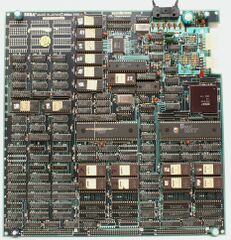
| |||||||||
| Sega OutRun hardware | |||||||||
|---|---|---|---|---|---|---|---|---|---|
| Manufacturer: Sega Enterprises, Ltd. | |||||||||
|
Sega's OutRun hardware was released in 1986 with the driving game OutRun. It is a successor to their Hang-On hardware, making it the second in Sega's Super Scaler series of three-dimensional arcade hardware. It was succeeded by the Sega X Board in 1987.
The OutRun hardware, like the Hang-On hardware, has specifications similar to those of the System 16, with the addition of a second 68000 processor and a separate video board which allowed for an extra graphics layer for the road as well as sprite/texture scaling capabilities. The OutRun hardware can do everything the Hang-On hardware can do, but its processors are clocked higher (allowing for quicker calculations), it has more memory and faster bandwidth, and the video board's capabilities have been expanded, capable of drawing two roads (the Hang-On hardware can only draw one) and rendering sprites/textures using a framebuffer system with a higher fillrate (the Hang-On hardware used a line-buffer system). At the time, the OutRun hardware was a very powerful but expensive arcade board, with arcade operators advised to charge twice as many credits than for regular arcade machines.
Three games made use of the hardware, all of which are driving games. However, only OutRun and Turbo OutRun are truly for this hardware, as Super Hang-On was also released for the Hang-On hardware in a mostly identical form.
Contents
Technical specifications
Sega OutRun specifications
- Board composition: CPU Board (Main Board), Video Board[1]
- Main CPU: 2× 68000 @ 12.5 MHz: 16/32‑bit instructions, 4.375 MIPS, 32‑bit (2× 16‑bit) data bus, 44‑bit (24‑bit, 20‑bit) address bus[2]
- Memory Mapper FPGA: Sega 315‑5195 Memory Mapper @ 40 MHz: 16‑bit data bus, 24‑bit address bus[3][2]
Sound
- Sound CPU: Zilog Z80 @ 4 MHz (8/16‑bit instructions, 0.58 MIPS)
- Sound chips: 2 chips, 24 channels, 24‑bit bus width[4]
- FM synthesis chip: Yamaha YM2151 @ 4 MHz (8 FM channels, 8‑bit bus width)[5]
- PCM sampling chip: SegaPCM 315‑5218 Sound Controller @ 4/16 MHz[1] (stereo output, 16 PCM channels, 12‑bit audio depth,[6] 31.25 kHz sampling rate, 16‑bit bus width)
Graphics
- Video Board GPU: Sega 171‑5377 VIDEO Board graphics chipset @ 25.1748 MHz: 6 processors, 80‑bit RAM (167.521366 MB/s), 64‑bit ROM (37 MB/s)[1][3][4]
- 315‑5197 Sega Custom Tilemap Generator FPGA: 16‑bit RAM (15.384615 MHz, 65 ns, 30.76923 MB/s), 24‑bit ROM (4 MHz, 250 ns, 12 MB/s)
- 315‑5211 Sega Custom Sprite Generator FPGA: 16‑bit sprite attribute RAM (22.222222 MHz, 45 ns, 44.444444 MB/s),[10] 48‑bit sprite framebuffer RAM (15.384615 MHz, 65 ns, 92.307692 MB/s),[11] 32‑bit ROM (5 MHz, 200 ns, 20 MB/s)[12]
- 315‑5227A Signetics CK2678 PAL: 8‑bit ROM (5 MHz, 200 ns, 5 MB/s)[12]
- 315‑5228 Signetics CK2605 FPGA: 8‑bit[8][9]
- 315‑5242 Sega Custom Color Encoder: 16‑bit
- 8255‑2 NEC µPD8255AC‑2: 24‑bit (3× 8‑bit) PPI (Programmable Peripheral Interface)[13]
- Main Board GPU: Sega 171‑5376 CPU Board graphics chipset @ 39.99967 MHz: 6 processors, 5‑bit RAM (6.25 MB/s), 16‑bit ROM (10 MB/s)[3][1][14]
- 2× 315‑5155 Sega Road Bit Extraction PAL: 16‑bit (2× 8‑bit), 2× 5 MHz ROM (200 ns, 10 MB/s)[12]
- 315‑5222 Signetics PLS153N Road Mixing FPGA: 8‑bit internal (33.333333 MHz),[15] 5‑bit RAM (10 MHz, 100 ns, 6.25 MB/s)
- 315‑5223A Signetics CK2605 FPGA: 8‑bit internal,[8][9] 4‑bit external
- 2× MMI PAL16R4 (315‑5225, 315‑5226) PAL: 16‑bit (2× 8‑bit)[16]
- Fixed-point arithmetic capabilities: Z-buffering, depth map[17]
- Video resolution: 320×224 (display), 400×262 (overscan),[1] progressive scan
- Scanlines: 224 (display), 262 (overscan)
- Refresh rate: 60.0543 Hz (V‑sync)[1]
- Frame rate: 30–60.0543 FPS
- Color palette: 98,304
- 16-bit color palette: 15‑bit RGB color depth (32,768 colors), 1‑bit shadow & highlight triples up to 98,304 colors
- Colors on screen: 12,288[1]
- Graphical planes:
- 2 tilemap layers
- 1 text layer
- 1 sprite layer
- 1 road layer
- Translucent shadows
- Video clock rate: 25.1748 MHz (60.0543 Hz refresh rate)
- Sprite plane: Sprite/Texture framebuffer, hardware sprite-scaling/zooming, 128 on‑screen sprites per frame, 7680 sprites/textures scaled per second, 16 colors (4‑bit) per sprite/texture
- Framebuffer: 512×256 resolution, double buffering,[6] 16-bit color depth
- Sprite/Texture sizes: 8×8 to 512×256 texels
- Framebuffer fillrate: 23.076923 MPixels/s (double buffering, 92.307692 MB/s)
- Texels per frame: 769,230 texels (30 FPS) to 384,267 texels (60.0543 FPS), 1466 texels per scanline, 128 sprites per scanline
- Tilemap planes: 2 tilemap layers, System 16B tilemap system, row/column scrolling, parallax scrolling[1][18]
- Tilemap resolution: 512×256 (1024×512 virtual resolution)
- Colors per tile: 8 colors (3‑bit)
- Tile size: 8×8 pixels (24 bytes)
- Tile fillrate: 15.384615 MPixels/s, 240,384 tiles/sec (5.769231 MB/s)
- Tiles per frame: 4002 tiles and 256,178 texels (60.0543 FPS) to 8012 tiles and 512,820 texels (30 FPS)
- Tiles per scanline: 978 texels, 122 tiles
- Colors per pixel: 8 colors (3‑bit)
- Road fillrate: 1024 texels per scanline, 268,288 texels per frame, 16.111848 MPixels/s (6.041943 MB/s)
Memory
- Memory: Up to 3.6 MB (736 KB main, 2496 KB video, 454 KB sound)
- RAM: 670 KB SRAM (Static RAM)[1][19]
-
- Sound RAM: 6 KB (3× 2 KB)[10]
Bandwidth
- RAM bandwidth:[19]
- Main RAM: 40 MB/s (32‑bit, 10 MHz, 100 ns)
- VRAM: 173.771366 MB/s (85‑bit)
- Sound RAM: 25 MB/s (24‑bit, 8.333333 MHz, 120 ns)[10]
- ROM bandwidth:[19]
Turbo OutRun specifications
The Turbo OutRun hardware is largely identical, but with the following changes:[22]
Graphics
- Video Board GPU: Sega 171‑5377 VIDEO Board graphics chipset @ 25.1748 MHz: 6 processors, 80‑bit RAM (189.898989 MB/s)
- Main Board GPU: Sega 171‑5376 CPU Board graphics chipset @ 39.99967 MHz: 6 processors, 5‑bit RAM (6.25 MB/s)
- Sprite plane:
Bandwidth
- RAM bandwidth:
- VRAM: 196.148989 MB/s (85‑bit)
List of games
- Out Run (1986)
- Super Hang-On (1987)
- Turbo OutRun (1989)
- Limited Edition Hang-On (1991)
Production credits
Magazine articles
- Main article: Sega OutRun hardware/Magazine articles.
Photo gallery
References
- ↑ 1.00 1.01 1.02 1.03 1.04 1.05 1.06 1.07 1.08 1.09 1.10 Sega OutRun hardware (MAME)
- ↑ 2.0 2.1 File:OutRun Schematics.pdf, page 2
- ↑ 3.0 3.1 3.2 Sega 16‑Bit common hardware (MAME)
- ↑ 4.0 4.1 4.2 File:OutRun Schematics.pdf, page 8
- ↑ File:YM2151 datasheet.pdf
- ↑ 6.0 6.1 6.2 Sega "X-Board" hardware notes (2004-12-03)
- ↑ File:YM3012 datasheet.pdf
- ↑ 8.0 8.1 8.2 File:303A-011A Device List.pdf, page 11
- ↑ 9.0 9.1 9.2 File:CK2605 Fusemap.pdf
- ↑ 10.0 10.1 10.2 10.3 10.4 File:TMM2018 datasheet.pdf
- ↑ 11.0 11.1 11.2 11.3 11.4 File:HM65256B datasheet.pdf
- ↑ 12.0 12.1 12.2 12.3 File:M27256 datasheet.pdf
- ↑ File:UPD8255A datasheet.pdf
- ↑ File:OutRun Schematics.pdf, page 5
- ↑ File:PLS153 datasheet.pdf
- ↑ File:PAL16R datasheet.pdf
- ↑ 17.0 17.1 Lou's Pseudo 3D Page
- ↑ Sega System 16B hardware notes (2003-01-12)
- ↑ 19.0 19.1 19.2 File:OutRun Schematics.pdf
- ↑ File:TMM2063P datasheet.pdf
- ↑ File:TurboOutRun Arcade JP Flyer.pdf, page 2
- ↑ Inside Manufactured Products: Sega's Turbo OutRun Arcade Machine
- ↑ https://www.4gamer.net/games/999/G999905/20210126043/ (Wayback Machine: 2021-02-05 15:00)
- ↑ Sega Saturn Magazine, "June 1995" (JP; 1995-05-08), page 65
| Sega arcade boards |
|---|
| Originating in arcades |
|
77
78
79
80
81
82
83
84
85
86
87
88
89
90
91
92
93
94
95
96
97
98
99
|
| Console-based hardware |
|
84
85
86
87
88
89
90
91
92
93
94
95
96
97
98
99
00
01
02
03
04
05
06
07
08
09
10
11
12
13
14
|
| PC-based hardware |
|
05
06
07
08
09
10
11
12
13
14
15
16
17
18
19
20
21
22
23
|
